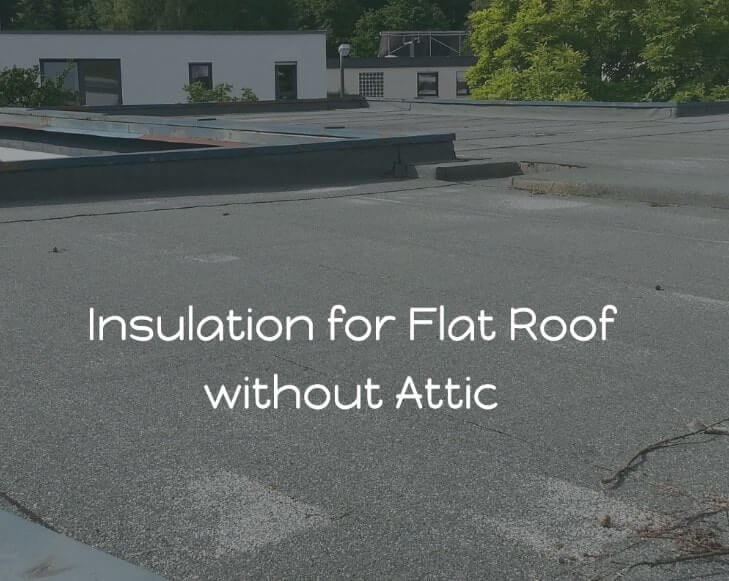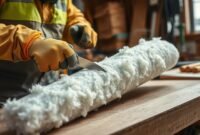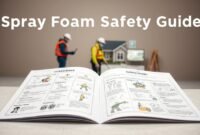Do you struggle with high energy bills and uncomfortable temperatures in your home? This is often due to poor insulation on flat roofs without attics. Such roofs can suffer from moisture damage, heat loss, and expensive repairs.
I’m here to show you how the right insulation can change your home’s energy use. My guide will cover the latest methods to boost comfort, efficiency, and safety in your home.

Understanding Flat Roof Systems and Their Unique Insulation Needs
Flat roofs are different from traditional roofs. They need special materials and insulation to stay efficient and avoid damage.
Exploring flat roof insulation can be tricky. I’ll explain the important points for homeowners and contractors to know about these roofs.
Types of Flat Roof Structures
Flat roofs have two main types, each needing its own insulation:
- Warm Roof Systems: Insulation is above the roof deck, acting as a thermal barrier
- Cold Roof Systems: Insulation is between roof joists, allowing for ventilation
Importance of Proper Insulation
Good insulation in flat roofs does more than keep temperatures right. It also stops moisture, saves energy, and makes your roof last longer.
Common Insulation Challenges
Flat roofs have specific insulation problems:
- Water can pool and leak
- There are fewer ways to ventilate
- Thermal bridging is a bigger risk
- They face more temperature changes
Knowing these issues helps choose the best insulation and keeps your building safe.
Assessing Your Flat Roof Before Insulation Installation
Before starting insulation for flat roofs, a detailed check is key. I’ll guide you through the steps to evaluate your roof’s state before adding insulation. This ensures you pick the best insulation and avoid future problems.
- Structural integrity check
- Moisture detection
- Existing insulation evaluation
- Surface condition analysis
Choosing the right insulation for attics and flat roofs needs a close look. A thorough visual check is advised. Look for signs like:
- Water stains or leak points
- Structural sagging or deformation
- Existing insulation wear
- Surface material condition
Roofing pros use special tools to find hidden issues. These tools show problems that could ruin your insulation. Watch out for areas where water might get in, as it can harm your insulation’s work and life.
A careful check before installing insulation sets you up for success. It boosts your roof’s energy use and keeps your property safe from damage.
Best Insulation Materials for Flat Roofs
Choosing the right insulation for a flat roof is key for saving energy and lasting well. Different materials offer special benefits for flat roofs without attics. I’ll show you the top picks for keeping your roof warm or cool.
It’s important to know what each insulation material does best. We’ll look at the best ways to keep a roof without an attic cool and comfy.
Polyisocyanurate (PIR) Insulation Boards
PIR boards are a top pick for flat roofs. They are rigid foam panels that keep heat out and moisture away. They are great because they:
- Have a high R-value per inch
- Are fire-resistant
- Don’t absorb much moisture
- Are light and easy to put up
Expanded Polystyrene (EPS) Insulation
EPS is a budget-friendly choice for flat roofs. It keeps the temperature right and has many good points:
- Is affordable
- Is light
- Keeps moisture out
- Has consistent heat properties
Spray Foam Solutions
Spray foam insulation makes a tight seal on flat roofs. It’s great for roofs without attics because it:
- Seals air well
- Keeps heat in or out
- Blocks moisture
- Fills in gaps fully
| Insulation Type | R-Value per Inch | Cost Effectiveness | Moisture Resistance |
|---|---|---|---|
| PIR Boards | 5.7-6.0 | Medium | Excellent |
| EPS | 3.8-4.4 | High | Good |
| Spray Foam | 6.0-7.0 | Low | Superior |
It’s wise to talk to a pro to find the best insulation for your flat roof. Each material has its own strengths that can make your roof more energy-efficient.
Insulation for Flat Roof without Attic: Professional Methods

Professional contractors have many ways to insulate roofs without an attic. These methods help keep homes warm and save energy, even with flat roofs.
There are three main professional methods for insulating flat roofs:
- Ceiling Rafter Insulation
- Exterior Roof Surface Insulation
- Ceiling Insulation from Below
Ceiling rafter insulation puts insulation between the roof’s rafters. It needs careful placement to avoid gaps that could reduce insulation’s effectiveness.
Exterior roof surface insulation adds insulation boards on top of the roof. This creates a barrier that stops heat from escaping and boosts energy efficiency.
Read also: Can You Paint Foam Board Insulation?
The third method involves insulating the ceiling from underneath. Experts use special materials to cover the roof’s underside. This method works well in tight spaces.
Each insulation method requires special skills. Homeowners should talk to experienced professionals. They know how to handle the unique challenges of flat roof insulation.
Warm Roof vs Cold Roof Insulation Techniques
Understanding the difference between warm and cold roof insulation can save you a lot of energy. It also helps prevent moisture problems. Let’s explore these two important methods to help you choose the right one for your flat roof.
Flat roofs face unique challenges with ventilation and insulation. The insulation method you pick will determine if your flat roof needs ventilation.
Warm Roof Construction Benefits
Warm roof systems have many benefits for flat roofs:
- Insulation is placed directly above the roof deck
- Creates a continuous thermal barrier
- Reduces the chance of condensation
- Improves energy efficiency
Cold Roof Installation Process
Cold roof techniques are different from warm roof methods. In this method, insulation goes between roof joists, creating a space above it. This space needs good ventilation to avoid moisture buildup.
Here’s a quick comparison of warm and cold roof approaches:
| Feature | Warm Roof | Cold Roof |
|---|---|---|
| Insulation Location | Above roof deck | Between roof joists |
| Ventilation | Minimal | Required |
| Energy Efficiency | High | Moderate |
The right choice depends on your building needs, climate, and budget. Talking to a roofing expert can help you pick the best insulation for your flat roof.
Moisture Control and Ventilation Requirements
Keeping your flat roof dry is essential for its long life. When you install insulation, knowing how to control moisture is critical. I’ll share important tips to keep your roof in top shape.
Moisture can quietly harm your flat roof. Without good ventilation, condensation can cause damage and mold. Here are three main steps to manage moisture:
- Vapor barrier installation
- Proper sealing techniques
- Strategic ventilation design
Choosing the right insulation is your first defense against moisture. Closed-cell spray foam is better at keeping moisture out than other materials. Make sure to cover the entire roof with spray foam for a solid barrier.
Read also: Should I Spray Foam My Attic Roof?
Ventilation is also vital for controlling moisture. I recommend a good ventilation system that lets air in but keeps moisture out. This might include:
- Perimeter vents
- Ridge ventilation
- Mechanical exhaust systems
Getting a professional to install is important for effective moisture control. Choose contractors who know how to handle flat roofs and can set up good moisture control systems.
Installation Process and Best Practices
Insulating an existing flat roof needs careful planning and precise steps. I’ll guide you through the key steps to insulate your roof well. This will make your building more energy efficient and protected.
Before starting, it’s important to prepare well. You need to check and get your roof ready for insulation.
Preparation Steps
- Do a detailed roof check for damage
- Clean the roof surface completely
- Fix any structural problems or weak spots
- Look for moisture issues and fix them right away
- Measure the roof area accurately for the right amount of materials
Installation Sequence
- Put in a top-notch vapor barrier
- Place insulation boards carefully
- Make sure there are no gaps
- Secure the insulation with the right fasteners
- Seal all edges and air leak points
Safety Considerations
When insulating your roof, safety is key. Always wear protective gear and use fall protection. Work with a partner if you can. Also, check the weather and avoid installing in wet or very cold conditions.
Professional tip: If you’re not sure about DIY, think about getting a certified roofer. They can ensure a great job.
Cost Considerations and ROI Analysis

When planning insulation for your flat roof, it’s important to think about the money involved. At first, the cost might seem high. But the benefits over time are often worth it.
Let’s look at the main money points of residential roofing insulation:
- Average material costs range from $1.50 to $3.50 per square foot
- Professional installation adds $2 to $4 per square foot
- Total project costs typically run between $5,000 and $15,000
The ROI for good roof insulation is great. You can save up to 30% on heating and cooling costs. This means your money could come back in 5-7 years through lower bills.
Think about these things when figuring out your savings:
- Local climate conditions
- Current energy efficiency of your home
- Insulation material selected
- Quality of installation
I suggest getting quotes from certified roofing pros. They can give you a detailed cost breakdown for your roof and home.
Common Mistakes to Avoid During Flat Roof Insulation
Insulating a flat roof without an attic can be tricky. Many homeowners make critical errors. These mistakes can make insulation less effective and lead to expensive repairs later.
I’ve seen many projects go wrong because of common oversights. Knowing these pitfalls can save you a lot of time and money. It’s important to avoid these mistakes in your flat roof insulation project.
- Neglecting proper moisture barriers, which can lead to water damage
- Choosing incorrect type of insulation for your specific roof structure
- Skipping professional assessment of the existing roof condition
- Inadequate ventilation that traps moisture and promotes mold growth
- Ignoring local building codes and climate-specific requirements
When working with attic space alternatives in flat roof designs, precision matters. One of the most critical mistakes is selecting insulation materials without considering thermal performance and moisture resistance.
My recommendation is to consult with a professional. They understand the nuanced requirements of flat roof insulation. They can guide you through material selection, installation techniques, and structural challenges unique to your building.
Remember, cutting corners during insulation can cause long-term damage and reduce energy efficiency. Spending time and resources upfront will save you in the long run.
Conclusion
Exploring insulation for flat roofs without attics has taught me a lot. Successful roofing projects need careful planning and the right steps. This can make your home more energy-efficient and protect your investment for years.
It’s important to know the challenges of flat roofs. Choosing the right insulation materials and controlling moisture are key. Homeowners who learn about these details can save money and avoid structural problems.
Whether you hire pros or do it yourself, focus on quality and precise installation. Flat roof insulation needs attention to detail. By following this guide, you’ll have a strong, energy-saving roof that faces environmental challenges well.
Your flat roof is vital to your home’s performance. Understanding and using the right insulation techniques will improve comfort, save energy, and last longer.


